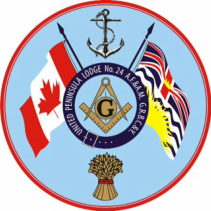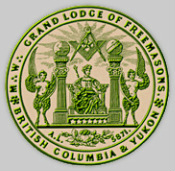
History of the United Peninsula No. 24 Pin
United Peninsula Lodge No. 24 although relatively new as a Lodge has deep roots in the Communities from which the core Lodges served. United Service Lodge No. 24 is honoured by the anchor at the top to represent the history of members in the Navy, a tradition which continues to this day. Mount Newton Lodge No. 89 is represented by the Sheaf of Wheat and reflects the rural and farming community of Central Saanich in the early days of the Lodge. Wheat typically symbolizes home and hearth and as such the Masonic Hall in Central Saanich is home to our new Lodge. Sidney Lodge No. 143 received its initial support from United Service Lodge No. 24 and is represented by the blue background to reflect Sidney by the Sea. All three Lodges with unique Histories but shared Community and Masonic Values come together in expressing allegiance to our Country and Province as represented by the flags on either side. A.F.A.M...Ancient Free and Accepted Masons
Where does that come from? Explanation From the Grand Lodge of British Columbia & Yukon:
Lodges and Grand Lodges whose charters' roots derive from the United Grand Lodge of Ancient Freemasons of England , The Grand Lodge of Ireland or the Grand Lodge of Ancient Free and Accepted Masons of Scotland use the expression, A∴F∴& A∴M∴ For the full story, please click HERE!
|
Chronology of the Journey
We use the expression ‘denominated’ followed by the number. Denominated means the name of the Lodge - e.g. denominated United Service Lodge and numbered 24 on the Register of the Grand Lodge of British Columbia and Yukon. This would mean United Service was the 24th Lodge registered in the records of Grand Lodge. Similarly, Mount Newton was the 89th Lodge, and Sidney was the 143rd Lodge registered on the records of Grand Lodge. At the time Sidney Lodge was registered it wouldn’t mean there were 143 Lodges existing in British Columbia, just that it was the 143rd registered. There may have been Lodges registered over the years which closed or even joined with other Lodges. In this case the second Lodge [i.e. the more junior Lodge] would give up its Charter and assume the number of the older Lodge. When Mount Newton Lodge No. 89 and Sidney Lodge 143 joined together they assumed the number 89 and the Lodge numbered 143 became history. Similarly when United Service No. 24 and what was already a renamed Saanich Peninsula Lodge No. 89 joined forces, they assumed the No. 24 and became United Peninsula Lodge. As time moves on and changes take place within communities there may not be enough members to sustain a Lodge. At that point the members would be faced with one of two choices – dissolve their Lodge and return their Charter along with any assets to Grand Lodge or find another Lodge they can amalgamate with, and both Lodges then share in their combined assets and liabilities. When Lodges are faced with smaller and smaller numbers and then have to make a decision it can be very difficult. Some members with a history may not be inclined to give up their Charter. Some members may decide they don’t want to belong to another Lodge. At the end of the day – the members take a vote and then make their decision as to where their membership in a Masonic Lodge will reside. Some members opt not to continue and ask for a ‘demit’. A demit is a document confirming the member is no longer a member of a particular Masonic Lodge – yet should he wish to join another Lodge – he is in good standing. The grouped Lodge (No. 24 ) so-far has produced 2 Grand Masters ( Cato Sharp 1903/1904 and Henry Rutter 1964/1963 ). More importantly Henry A. Larson of St. Roch fame was a member of Mount Newton No. 89; an unsung hero, who because of his Polar Transits in the 1940’s established Canadian boundaries and sovereignty! |
